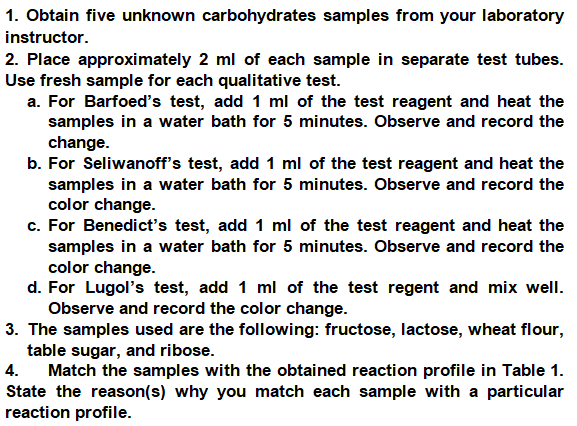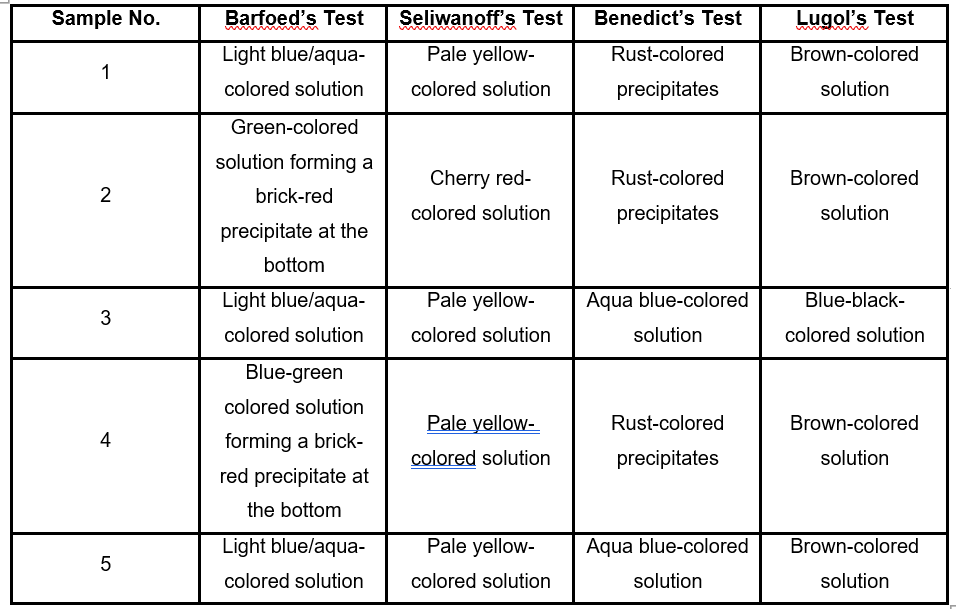1. Obtain five unknown carbohydrates samples from your laboratory instructor. 2. Place approximately 2 ml of each sample in separate test tubes. Use fresh sample for each qualitative test. a. For Barfoed's test, add 1 ml of the test reagent and heat the samples in a water bath for 5 minutes. Observe and record the change. b. For Seliwanoff's test, add 1 ml of the test reagent and heat the samples in a water bath for 5 minutes. Observe and record the color change. c. For Benedict's test, add 1 ml of the test reagent and heat the samples in a water bath for 5 minutes. Observe and record the color change. d. For Lugol's test, add 1 ml of the test regent and mix well. Observe and record the color change. 3. The samples used are the following: fructose, lactose, wheat flour, table sugar, and ribose. 4. Match the samples with the obtained reaction profile in Table 1. State the reason(s) why you match each sample with a particular reaction profile.
1. Obtain five unknown carbohydrates samples from your laboratory instructor. 2. Place approximately 2 ml of each sample in separate test tubes. Use fresh sample for each qualitative test. a. For Barfoed's test, add 1 ml of the test reagent and heat the samples in a water bath for 5 minutes. Observe and record the change. b. For Seliwanoff's test, add 1 ml of the test reagent and heat the samples in a water bath for 5 minutes. Observe and record the color change. c. For Benedict's test, add 1 ml of the test reagent and heat the samples in a water bath for 5 minutes. Observe and record the color change. d. For Lugol's test, add 1 ml of the test regent and mix well. Observe and record the color change. 3. The samples used are the following: fructose, lactose, wheat flour, table sugar, and ribose. 4. Match the samples with the obtained reaction profile in Table 1. State the reason(s) why you match each sample with a particular reaction profile.
Chapter8: Forms Of Drugs And How They Act
Section: Chapter Questions
Problem 30RQ
Related questions
Question
100%
Identify the unknown carbohydrate sample and give it's rationale

Transcribed Image Text:1. Obtain five unknown carbohydrates samples from your laboratory
instructor.
2. Place approximately 2 ml of each sample in separate test tubes.
Use fresh sample for each qualitative test.
a. For Barfoed's test, add 1 ml of the test reagent and heat the
samples in a water bath for 5 minutes. Observe and record the
change.
b. For Seliwanoff's test, add 1 ml of the test reagent and heat the
samples in a water bath for 5 minutes. Observe and record the
color change.
c. For Benedict's test, add 1 ml of the test reagent and heat the
samples in a water bath for 5 minutes. Observe and record the
color change.
d. For Lugol's test, add 1 ml of the test regent and mix well.
Observe and record the color change.
3. The samples used are the following: fructose, lactose, wheat flour,
table sugar, and ribose.
4.
Match the samples with the obtained reaction profile in Table 1.
State the reason(s) why you match each sample with a particular
reaction profile.

Transcribed Image Text:Sample No.
1
2
3
4
LO
5
Barfoed's Test
Light blue/aqua-
colored solution
Green-colored
solution forming a
brick-red
precipitate at the
bottom
Light blue/aqua-
colored solution
Blue-green
colored solution
forming a brick-
red precipitate at
the bottom
Light blue/aqua-
colored solution
Seliwanoff's Test
Pale yellow-
colored solution
Cherry red-
colored solution
Pale yellow-
colored solution
Pale yellow-
colored solution
Pale yellow-
colored solution
Benedict's Test
Rust-colored
precipitates
Rust-colored
precipitates
Aqua blue-colored
solution
Rust-colored
precipitates
Aqua blue-colored
solution
Lugol's Test
Brown-colored
solution
Brown-colored
solution
Blue-black-
colored solution
Brown-colored
solution
Brown-colored
solution
Expert Solution
This question has been solved!
Explore an expertly crafted, step-by-step solution for a thorough understanding of key concepts.
Step by step
Solved in 3 steps with 1 images

Recommended textbooks for you







